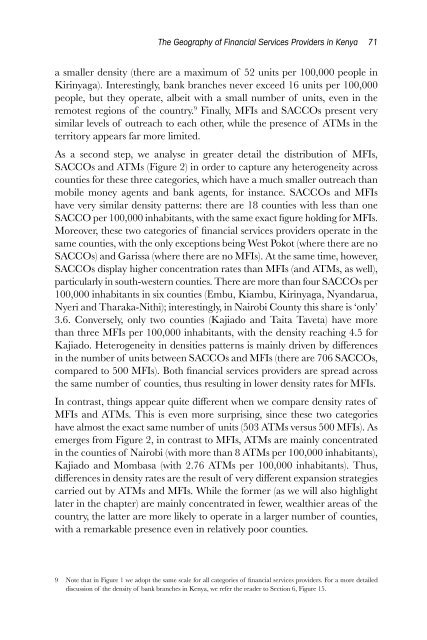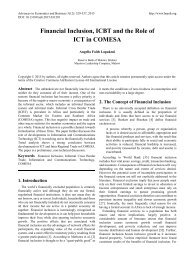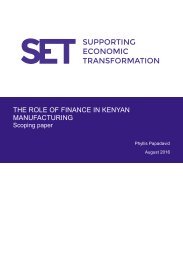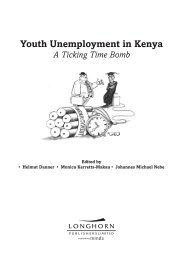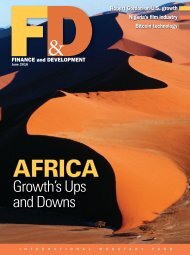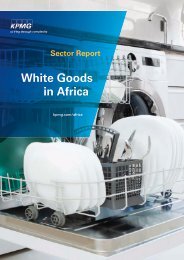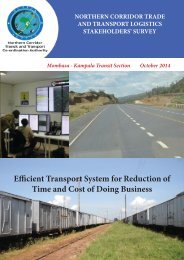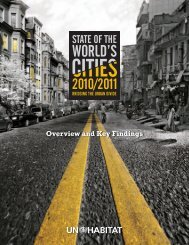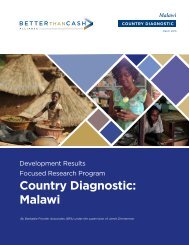in the 21st Century
hTOE305aYVW
hTOE305aYVW
You also want an ePaper? Increase the reach of your titles
YUMPU automatically turns print PDFs into web optimized ePapers that Google loves.
The Geography of F<strong>in</strong>ancial Services Providers <strong>in</strong> Kenya 71<br />
a smaller density (<strong>the</strong>re are a maximum of 52 units per 100,000 people <strong>in</strong><br />
Kir<strong>in</strong>yaga). Interest<strong>in</strong>gly, bank branches never exceed 16 units per 100,000<br />
people, but <strong>the</strong>y operate, albeit with a small number of units, even <strong>in</strong> <strong>the</strong><br />
remotest regions of <strong>the</strong> country. 9 F<strong>in</strong>ally, MFIs and SACCOs present very<br />
similar levels of outreach to each o<strong>the</strong>r, while <strong>the</strong> presence of ATMs <strong>in</strong> <strong>the</strong><br />
territory appears far more limited.<br />
As a second step, we analyse <strong>in</strong> greater detail <strong>the</strong> distribution of MFIs,<br />
SACCOs and ATMs (Figure 2) <strong>in</strong> order to capture any heterogeneity across<br />
counties for <strong>the</strong>se three categories, which have a much smaller outreach than<br />
mobile money agents and bank agents, for <strong>in</strong>stance. SACCOs and MFIs<br />
have very similar density patterns: <strong>the</strong>re are 18 counties with less than one<br />
SACCO per 100,000 <strong>in</strong>habitants, with <strong>the</strong> same exact figure hold<strong>in</strong>g for MFIs.<br />
Moreover, <strong>the</strong>se two categories of f<strong>in</strong>ancial services providers operate <strong>in</strong> <strong>the</strong><br />
same counties, with <strong>the</strong> only exceptions be<strong>in</strong>g West Pokot (where <strong>the</strong>re are no<br />
SACCOs) and Garissa (where <strong>the</strong>re are no MFIs). At <strong>the</strong> same time, however,<br />
SACCOs display higher concentration rates than MFIs (and ATMs, as well),<br />
particularly <strong>in</strong> south-western counties. There are more than four SACCOs per<br />
100,000 <strong>in</strong>habitants <strong>in</strong> six counties (Embu, Kiambu, Kir<strong>in</strong>yaga, Nyandarua,<br />
Nyeri and Tharaka-Nithi); <strong>in</strong>terest<strong>in</strong>gly, <strong>in</strong> Nairobi County this share is ‘only’<br />
3.6. Conversely, only two counties (Kajiado and Taita Taveta) have more<br />
than three MFIs per 100,000 <strong>in</strong>habitants, with <strong>the</strong> density reach<strong>in</strong>g 4.5 for<br />
Kajiado. Heterogeneity <strong>in</strong> densities patterns is ma<strong>in</strong>ly driven by differences<br />
<strong>in</strong> <strong>the</strong> number of units between SACCOs and MFIs (<strong>the</strong>re are 706 SACCOs,<br />
compared to 500 MFIs). Both f<strong>in</strong>ancial services providers are spread across<br />
<strong>the</strong> same number of counties, thus result<strong>in</strong>g <strong>in</strong> lower density rates for MFIs.<br />
In contrast, th<strong>in</strong>gs appear quite different when we compare density rates of<br />
MFIs and ATMs. This is even more surpris<strong>in</strong>g, s<strong>in</strong>ce <strong>the</strong>se two categories<br />
have almost <strong>the</strong> exact same number of units (503 ATMs versus 500 MFIs). As<br />
emerges from Figure 2, <strong>in</strong> contrast to MFIs, ATMs are ma<strong>in</strong>ly concentrated<br />
<strong>in</strong> <strong>the</strong> counties of Nairobi (with more than 8 ATMs per 100,000 <strong>in</strong>habitants),<br />
Kajiado and Mombasa (with 2.76 ATMs per 100,000 <strong>in</strong>habitants). Thus,<br />
differences <strong>in</strong> density rates are <strong>the</strong> result of very different expansion strategies<br />
carried out by ATMs and MFIs. While <strong>the</strong> former (as we will also highlight<br />
later <strong>in</strong> <strong>the</strong> chapter) are ma<strong>in</strong>ly concentrated <strong>in</strong> fewer, wealthier areas of <strong>the</strong><br />
country, <strong>the</strong> latter are more likely to operate <strong>in</strong> a larger number of counties,<br />
with a remarkable presence even <strong>in</strong> relatively poor counties.<br />
9 Note that <strong>in</strong> Figure 1 we adopt <strong>the</strong> same scale for all categories of f<strong>in</strong>ancial services providers. For a more detailed<br />
discussion of <strong>the</strong> density of bank branches <strong>in</strong> Kenya, we refer <strong>the</strong> reader to Section 6, Figure 15.


